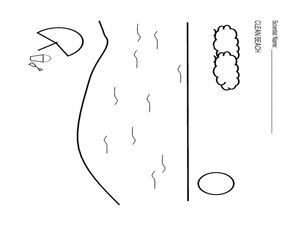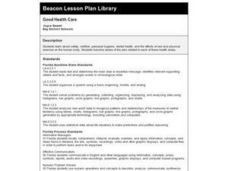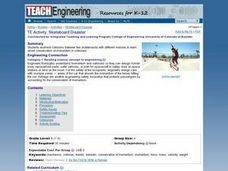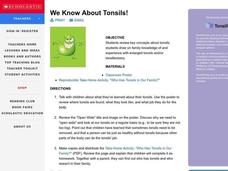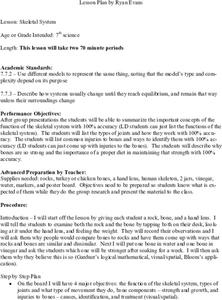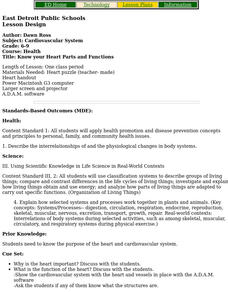Curated OER
MICROBES 1: WHAT'S BUGGIN YOU?
Middle schoolers use existing knowledge of microbes, focusing on the relationship between microorganisms and foodborne illness, as well as the implications that foodborne illness has on human health.
Curated OER
Cells All Around
Young scholars measure the size of an epithelial cell and to estimate the number of epithelial cells in a given area of the body. After watching a video on cells, student groups perform an experiment using a microscope to view some of...
Curated OER
Fish Hazards
Young scholars study the Pacific salmon and see the different challenges they face. In this environment lesson students complete several activities that show how humans have affected the salmon environment. These activities have...
Curated OER
Good Health Care
Students work in collaborative groups researching topics such as nutrition, the benefits of exercise on the body, dental and personal hygiene. They conduct interviews, create charts and posters, and report their results with a written...
Curated OER
"ART ZOO 'Blacks in the Westward Movement', 'What Can You Do with a Portrait', and 'Of Beetles, Worms, and Leaves of Grass'"
Students study black history, examine portraits and portrait making and create their own portraits, and investigate their natural environment. This humanities lesson provides a text that can be used to teach lessons in black...
Curated OER
A Teeth Changing Experience
Students research human health by reading an educational story in class. In this oral health lesson, students identify the importance of brushing their teeth and consuming calcium. Students read the book A Teeth Changing Experience...
Curated OER
Plants and Animals, Partners in Pollination
Students participate in multiple hands-on activities to explore reproduction and pollination. In groups, using a cotton swab and powder, students simulate being pollinators and plants. They name the parts of the flowers and the function...
Curated OER
Skateboard Disaster
Learners conduct a hands-on experiment with collisions between two skateboards of different masses. They are introduced to the concept of conservation of momentum in collisions and consider how their observations might help engineers...
Curated OER
Ya' Gotta Have Heart
Fourth graders study the parts of the human circulatory system and how they function. They design a flow chart of the circulatory system and use data to construct charts and graphs.
Curated OER
We Know About Tonsils
Learners engage in a lesson that is concerned with the use of tonsils in the human body. They brainstorm in small groups to review the location and purpose of having tonsils. The teacher uses a poster to help students in the class...
Curated OER
Skeletal System
Seventh graders explore the functions of the skeletal system. They collaborate in small groups to determine the function of the skeletal system, the types of joints and movement, bone strength and growth, and bone injuries including...
Curated OER
Looking at Body Language
Students examine Dorothea Lange's photograph of a migrant mother and consider how artists express emotions, ideas, and physical conditions through gesture, pose, clothing, and expression.
Curated OER
Effects of Alcohol Use
Fifth graders identify short and long term effects of alcohol use. In this effects of alcohol lesson plan, 5th graders participate in activities to understand what it feels like to have alcohol in their system. With the teacher they make...
Curated OER
HUMAN/ENVIRONMENT INTERACTIONS: CLIMATE
Students explore the various global climates and apply cultural adaptations of the peoples in various zones due to climate.
Curated OER
Circulatory System Design
Students identify the different parts of the circulatory system and their function. They work together to create their own model of the system and use it to determine the rate of blood flow. They answer questions related to their model.
Curated OER
How Much of Each Nutrient Does Your Body Need, and How Can You Find Out What Is In Each Food?
Fifth graders practice reading food labels to find nutrients in foods. In this health lesson, 5th graders read food labels and discuss the recommended daily allowance of each nutrient. They compare this to the food pyramid and create a...
Curated OER
Enzymes
Tenth graders test their saliva for enzyme activity. In this enzyme lesson, 10th graders conduct an experiment to test the enzymatic activity of their saliva. They relate the lack of certain digestive enzymes with alcoholism.
Curated OER
Chancing it
Seventh graders examine different transplant types and estimate the possible outcomes. In this biology instructional activity students discuss donors and transplants then divide into groups and complete a worksheet.
Curated OER
Biology E3 Project Instructional Plan
Ninth graders design a device to treat aneurism. In this biology lesson, 9th graders create a polymer in the lab and explain its uses. They identify the different diseases affecting the circulatory system.
Curated OER
Human Number Line
Learners compare different types of numbers. Each student is given a flashcard containing a decimal, percent, fraction or integer. Teams of students compete, in silence, to determine who can line up in numerical order correctly. They...
Curated OER
Know your Heart Parts and Functions
Middle schoolers put together a 3-D interactive "heart" puzzle and learn the names of heart parts.
Curated OER
And The Beat Goes On...!
Students explore the circulatory system. They observe a dissection of a heart and view the path that blood takes through the heart and the circulatory system. Students identify the structures and functions of the heart. They write a...
Curated OER
Human Obstacle Course
Students are in a group - half of them be an obstacle and half be moving around them, and then they switch. This engaging game promotes lots of movement.
Curated OER
Hugging / Handshaking Muscle Stations
Students are introduced to the concept of "muscle overload." They work on hugging and handshaking muscles. Students are told that each station is set up to make muscles tired. They are told that making their muscles tired is a good...


